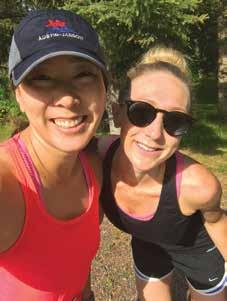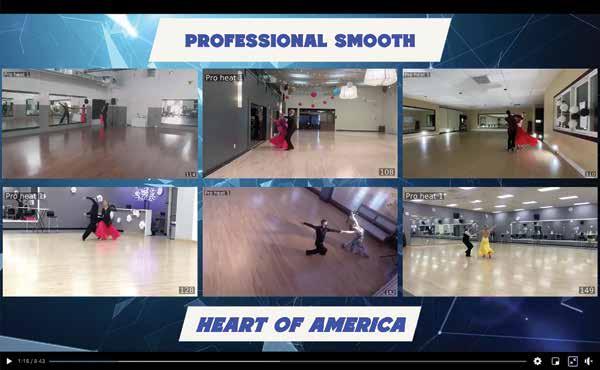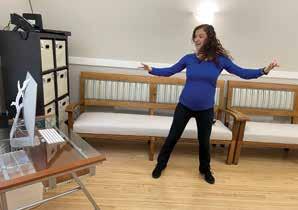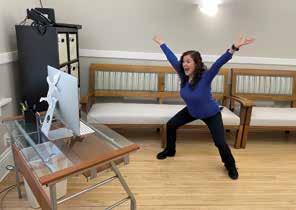
4 minute read
Making lemonade out of lemons Finding new ways to exercise during the pandemic
By Kasha Stoll
Background: Laura Johnson (right) and Briana Waldoch cross the finish line held by Laura’s children, Layla and Felix, at Park Point in this summer’s virtual Grandma’s Marathon.
Inset: Layla Johnson sets up shop to cheer on her mother, Laura, and her mother’s friend Bri Waldoch on race day.

Laura Johnson laughed and summed up 2020: “This is the year for making lemonade out of lemons.”
Johnson is an avid runner and the board chair for Grandma’s Marathon. Like many people, Johnson’s exercise schedule and plans were upended by the pandemic. Life goes on, though, and Johnson and others have found a way to continue, tweak or start their fitness routines.
Virtual races
Even though Johnson prefers the high energy, large crowds and controlled chaos of running in a typical Grandma’s Marathon, the 2020 virtual races will always hold a special place in her heart.
“I guess you could say I was feeling especially inspired — or crazy — and signed up to run all three Grandma’s Marathon weekend races,” Johnson said. “I was already registered for the Garry Bjorklund Half, but when the decision was made to transition all of the races to virtual events, I figured why not add in the Marathon and 5K, too.
Bri Waldoch and Laura Johnson are running buddies. Since Grandma’s Marathon was virtual this year, Laura, who is the Grandma’s Marathon board chair, ran it twice and submitted her best time. She also ran the 5K and half marathon.

“Now I have bragging rights of saying ‘I did all three weekend marathon races.’ No one has been able to do that before.”
And if that wasn’t enough, Johnson also ran the marathon twice in two weeks and then submitted her best time for the official record.
Ah, the benefits of virtual racing!
Zach Schneider, the marketing and public relations manager for Grandma’s Marathon, shared a few more benefits: there is no travel required; you can run on familiar roads and trails; and you can choose your own day and start time.
Of course, there are challenges, as well.
“Grandma’s Marathon is built on community, support and emotion,” Schneider said. “You don’t get that when you run virtually. I encourage people to get friends and family out there on the course to cheer the runner on. Have people at the finish line to say, ‘Good job!’”
Johnson’s family set up a makeshift finish line on Park Point and cheered as she and her running partner, Brianna Waldoch, crossed the
Continued on page 18 line. Her kids supported other runners during their virtual race on June 20 by handing out Gatorade and frozen grapes.
“Virtual races are a safe and healthy way for people to participate and feel like their run is more than a training run,” Schneider said. “It is what the event is supposed to be — a culmination of all the work and training. When you cross that finish line, you feel like you have completed something meaningful.”
Dance lessons
When Superior Ballroom Dance Studio, 21 N. Lake Ave. in Duluth, closed during the governor’s stay-at-home order in

March, the instructors were worried about their students. Some even volunteered to stay in contact with their students and help them stay motivated.

“You don’t maintain,” said Rae Lyons, the studio’s lead female instructor. “You either shut down and get worse, or you continue to improve.”
So, Lyons and her coworkers figured out how to teach dance lessons through Zoom. As with virtual racing, online dance lessons come with benefits and challenges.

“We have been able to work on higher-level techniques, and the students are improving their own balance,” Lyons said. With online lessons, “the students must be able to do the steps on their own. They can’t rely on balancing with their partner.
“One of my students literally used to say, ‘I want to be carried around the dance floor.’ She has learned to count on her own now. Her dancing has really improved because she had to take ownership of her own dancing.”
The biggest real challenge Lyons sees is with the technology. People must have a working internet connection and sufficient bandwidth to prevent picture freezing.
The biggest perceived challenge students face is a lack of space.
“People are usually fairly concerned that they don’t have enough space in their house or apartment,” Lyons said, “but most people want to be able to social dance, like at a wedding or a party. Anytime you are in a social dancing situation, you don’t have a lot of space.
“Practicing from home where you have weirdly shaped spaces or awkward angles is actually really helpful training for social dancing,” she said. “Throw yourself in a tiny space, and we will figure it out.”
Lyons said virtually training also works very well for beginning dancers.

“We teach in a very sequential process,” she said. “It is all about muscle memory. If somebody is brand new, the first couple of lessons are learning where your feet go on the floor. That translates pretty well via Zoom.”
Competitions
The competitive spirit can’t be squashed! Lyons has participated in an online ballroom dance competition, as have some of her students. Of course, the logistics have changed considerably. Rather than compete in a single location, the dancers perform in their studios and film their routines. The judges then upload the files and watch all the videos at once.
There are also new competition categories, like “Solo Stars” and no-touch events. In the latter, the student and teacher dance together but don’t touch.
“The industry has gotten really creative to come up with goals to keep everyone motivated,” Lyons said.
Continuing education
Debra Poldoski has been teaching belly dance classes through continuing education for at least 30 years. This year, she offered beginning classes via Zoom and works with her dance troupe.



Poldoski also takes classes herself.
“I take Zoom classes twice a week from a mentor in the Twin Cities,” she said. “I will never know everything there is to know about belly dancing. There is so much to learn. I am always learning so I have more to bring to my students. If I stop learning, they are never going to grow.” D
Kasha Stoll is a Duluth freelance writer.










